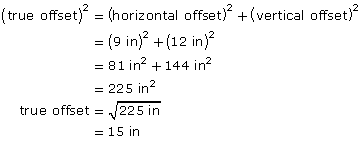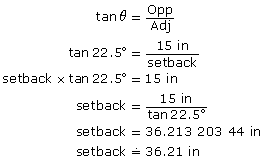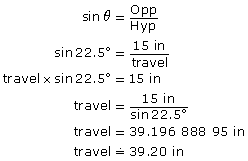Lesson 5
Completion requirements
Created by IMSreader
1. Lesson 5
1.7. Explore 3
Module 4: The Right Kind Of Triangles
Example
Plumbers must occasionally make use of a rolling offset to avoid obstacles when installing pipes. A rolling offset is when a pipe is shifted horizontally (left or right) and vertically (up or down). You can picture a rolling offset by thinking back to your work with the box in Discover. In the diagram, the pipe enters one corner at the bottom of the box and leaves by travelling diagonally to the opposite upper corner.

- For a vertical offset of 12 in and a horizontal offset of 9 in, what is the true offset? The true offset is the diagonal distance across the shaded end of the box.
- A complication in determining a rolling offset is that the diagonal travel uses a separate piece of pipe that must be joined to the horizontal sections. The fittings come in certain angles only. The fitting angle in the diagram, marked θ, is the angle between the diagonal travel (blue pipe) and the setback (dotted red horizontal line). If 22.5° fittings must be used, determine the setback. Round to the nearest hundredth of an inch.
- Determine the length of the diagonal travel. Round to the nearest hundredth of an inch.
Solution
|
 |
|
 |
|
 |
For another example, turn to page 191 of MathWorks 11. Work through “Example 3.”
Self-Check 1
- Gustav was standing on the balcony of a high-rise building, 50 m above the street below. He measured the angle of depression of a pedestrian on the street to be 76°. Gustav sketched a diagram and calculated the distance the pedestrian was from the point on the street directly below the balcony. His answer was approximately 200.5 m. Is Gustav’s answer reasonable? Why or why not? Support your answer with a diagram.
Answer

